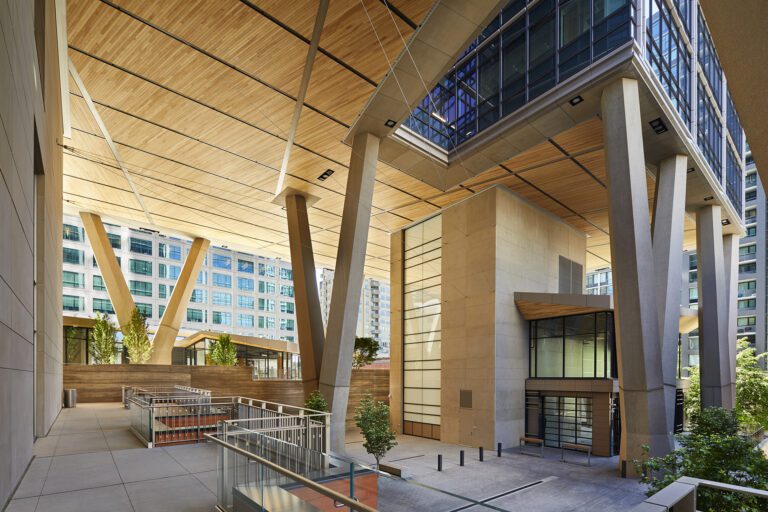Wall and ceiling panels offer more than surface coverage—they enhance commercial interiors with texture, depth, and sensory comfort. Once considered purely functional, these systems have evolved into design-defining elements that shape the character of a space while meeting performance requirements.
For architects and designers, wall and ceiling panels provide a way to balance aesthetic goals with measurable benefits like acoustics and sustainability. Unlike metal or gypsum, wood-based systems integrate structure and sound control in one solution, reducing the need for added materials. This combination of form and function makes them essential for performance-driven design strategies in modern commercial projects.
The Power of Three-Dimensional Visual Impact
Wall and ceiling panels are no longer confined to flat, neutral surfaces. Today’s systems combine texture, patterns, and color to create depth and dimension, turning plain planes into design features that shape the experience of a space. Through engineered geometries and surface treatments, panels add visual interest while maintaining acoustic and sustainable performance.
Texture as a Design Language
Texture operates as a subtle but powerful design tool. The interplay of materials, finishes, and color establishes the mood of a space before occupants even process visual details. Modern manufacturing techniques make it possible to introduce anything from fine linear textures to bold sculptural forms, creating movement and shadow play across surfaces. This layered approach transforms static walls and ceilings into dynamic architectural features.
Pattern Integration and Customization
Pattern selection directly influences how occupants perceive and use space. Linear designs can visually extend a corridor, while geometric patterns create focal points or define distinct zones within larger areas. Perforated panels provide additional design flexibility, acting as canvases for custom graphics or brand elements. With options such as grille systems or precision-cut flat veneer panels, architects can seamlessly integrate texture, pattern, and performance into cohesive design narratives.
Acoustic Performance Through Material Engineering
High-performance wall and ceiling panels do more than enhance aesthetics—they play a critical role in creating comfortable sound environments. By combining material engineering with design features like routed patterns and spacing, panels absorb excess noise far more effectively than standard building materials. This helps address the growing need for sound control in modern commercial interiors.
Real-World Acoustic Applications
Noise has a direct impact on how people experience a space. In restaurants, it affects comfort and conversation. In open-plan offices, it influences productivity. In worship spaces, it shapes moments of focus and reflection. By reducing echo and improving speech clarity, wall and ceiling panels allow each of these environments to function as intended—whether the goal is collaboration, privacy, or a sense of calm.
Material Innovation and Sustainability
Responsibly sourced wood remains one of the most sustainable building materials for commercial interiors. Many wall and ceiling panels meet rigorous environmental standards, offering FSC® certification and low-VOC finishes that support projects pursuing LEED or wellness-focused objectives. These sustainability credentials have become essential in commercial specifications where environmental responsibility and occupant health are priorities.
Certification and Environmental Standards
FSC-certified wood ensures responsible forestry practices, while CARB-compliant options limit emissions for healthier indoor environments. Rulon International also offers no-added-formaldehyde cores and products certified under Indoor Advantage™ Gold for air quality—demonstrating a commitment to both the planet and occupant wellbeing. These certifications provide measurable benefits while aligning with broader goals of carbon reduction and material transparency.
Biophilic Design Integration
Wood panels bring an organic character that few materials can replicate. Natural grain patterns and warm tones connect occupants with nature, a principle at the heart of biophilic design. Spaces designed with wood are often described as calming and restorative, helping corporate, healthcare, and educational settings feel more human-centered. Research shows that exposure to natural materials can lower stress and support wellbeing, reinforcing the business case for specifying wood in environments where occupant experience directly impacts outcomes.
Installation Flexibility and Technical Performance
Modern wall and ceiling panels are designed for versatility, making them adaptable to a wide variety of structural conditions, including masonry, drywall, grid systems, and wood substrates. Regardless of the surface, these systems maintain consistent performance and aesthetic quality.
Mounting Systems and Accessibility
Multiple installation methods give design teams and contractors options based on project needs. Backer clip systems improve alignment and allow for adjustments during installation, while screw-fastened systems provide a straightforward approach using familiar tools. Both methods balance speed during construction with accessibility for long-term maintenance.
Layout and Design Options
Tegular layouts add depth by positioning panels slightly lower than the grid, creating a shiplap-style effect where panels meet. This dimensional look enhances texture and visual rhythm across ceilings, adding character while preserving functional performance.
Long-Term Performance
Beyond installation, advanced panel systems support durability and hygiene. Certain products incorporate antimicrobial properties that resist mold, mildew, and odor-producing bacteria—features especially valuable in healthcare, education, and hospitality environments. These technologies ensure that panels maintain both their appearance and their acoustic performance over time.
Color and Finish Strategies
Color and finish choices are among the most powerful tools for shaping how people perceive and experience a space. A curated palette of neutrals, brights, and deep tones can establish timeless interiors while directly influencing occupant response. For commercial projects, finish specification becomes a critical design decision with both aesthetic and performance implications.
Wood panels bring natural warmth and variation that make spaces feel inviting and human-centered. A light maple veneer can deliver a clean, modern look, while walnut or reclaimed wood introduces depth and richness. Advanced systems such as Curvatone panels expand these options by incorporating three-dimensional finishes, adding movement and character to ceilings and walls.
Brand Integration Through Color
Panels can also reinforce brand identity when color is applied with intention. Accent walls, custom veneers, or vibrant finishes can reflect a company’s personality while supporting a cohesive design narrative. Whether used subtly or boldly, this strategic use of color enables architects to create distinctive environments that align with organizational culture while maintaining professional aesthetics suitable for diverse commercial settings.
Specification and Selection Criteria
Selecting the right wall and ceiling panels requires more than comparing acoustic ratings. While the Noise Reduction Coefficient (NRC) is a useful benchmark for sound absorption, successful specification also depends on fire ratings, sustainability credentials, and maintenance requirements—all of which must align with project-specific objectives and local codes.
Panels within Rulon’s portfolio meet some of the industry’s most rigorous environmental standards, supporting architects and designers who prioritize both performance and sustainability. For a deeper look at how material choices influence design outcomes, see why interior designers choose wood paneling for walls and ceilings.
Performance and Design Options
Different panel types allow designers to balance function and visual expression. Flat veneer panels provide consistent, large-scale coverage with refined finishes, making them ideal for expansive surfaces. By contrast, Curvatone panels introduce three-dimensional depth and curvature, creating signature focal points that elevate a project’s visual character. Together, these options give architects flexible tools for specifying systems that deliver both acoustic performance and design impact.
Future Considerations
Wood systems offer a rare balance of form and function. As commercial design continues to prioritize wellness, sustainability, and performance, wall and ceiling panels remain a proven technology that addresses multiple needs within a single solution.
Early collaboration between architects, contractors, and manufacturers ensures that design intent aligns seamlessly with technical performance. This integrated approach leads to smoother installations, more efficient construction, and systems that perform as expected for years to come.
By uniting texture, acoustic performance, and sustainable materials, wall and ceiling panels will continue to serve as essential components of contemporary interiors. For inspiration on how these systems are applied across sectors, explore the Rulon project gallery, which showcases projects where panels enhance both aesthetics and occupant experience.
Frequently Asked Questions
What NRC rating should I specify for commercial wall and ceiling panels?
Panels with higher sound absorption ratings are best suited for demanding environments like classrooms, healthcare facilities, and open offices. High-performance systems are designed to reduce echo and improve speech clarity, helping create spaces that are more comfortable, productive, and acoustically balanced.
How do wall and ceiling panels contribute to sustainability goals?
Wood-based panels are among the most sustainable options available. Many systems feature FSC® certification, low-VOC finishes, and no-added-formaldehyde cores, supporting LEED credits and indoor air quality objectives. These certifications demonstrate responsible sourcing while contributing to wellness-driven design goals.
What installation methods are available for wall and ceiling panels?
Panels can be installed on a wide range of surfaces, including masonry, drywall, and grid systems. Options such as backer clips or screw-fastening allow for precise alignment and long-term accessibility. In ceilings, layouts like Tegular add depth and texture by suspending panels slightly below the grid, enhancing both visual rhythm and acoustic performance.




